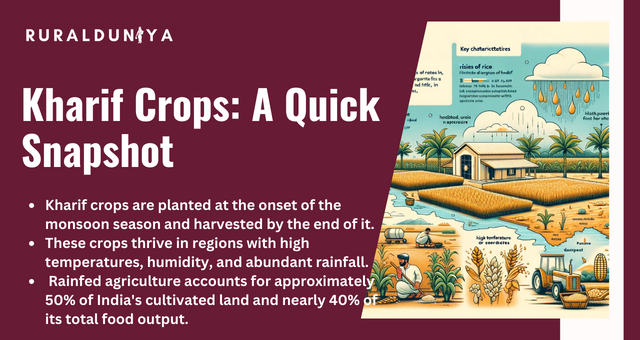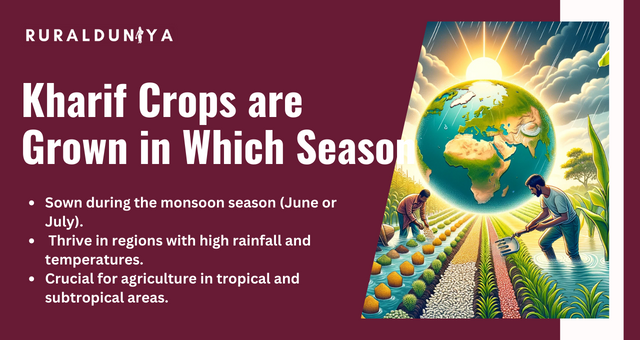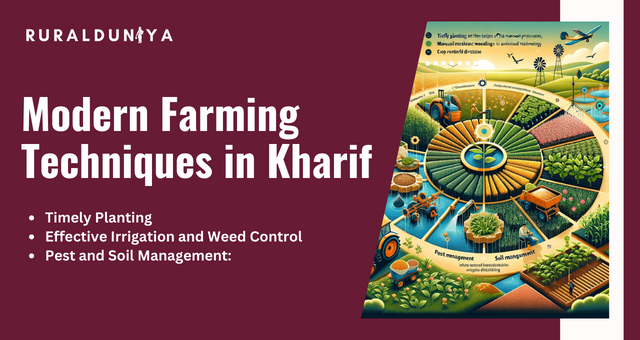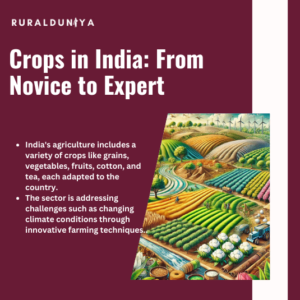Hola! With the monsoon season approaching, it is time to begin strategizing for Kharif crops, which are specifically suited for cultivation during the monsoon.
These crops include plants like rice. Typically, these crops are gathered during the monsoon period, which commences as early as May in certain regions of the Indian subcontinent.
Kharif Crops: A Quick Snapshot

Kharif, derived from Arabic, refers to the fall season. These kharif crops, predominantly harvested in September or October, are aligned with this season. These crops are commonly known as monsoon crops as they are sown or planted during the monsoon season.
Furthermore, they thrive in regions that receive water from rainfall and have high temperatures and humidity. The success of their growth and productivity is strongly influenced by the patterns of precipitation.
The seeds of these crops are planted at the onset of the monsoon season and reaped at its conclusion. Nevertheless, the duration of these crops’ growth cycle differs throughout different states in India.
Approximately 50% of India’s cultivated land and almost 40% of its overall food output are attributed to rainfed agriculture.
Kharif Season
Not all crops thrive during the same season. Various crops possess distinct characteristics and necessitate unique climatic conditions.
Crops in India are categorized into two major classifications based on the prevailing climatic conditions.
- Kharif crops
- Rabi crops
Kharif Crops are Grown in Which Season

These crops refer to agricultural crops that are sown during the monsoon season, usually in the months of June or July. These crops are ideally adapted to areas characterized by abundant precipitation and high temperatures.
They play a crucial role in agriculture in numerous countries worldwide, particularly in tropical and subtropical areas where the monsoon season ensures abundant water supply for crop cultivation.
Kharif Crops are Harvested In
These crops are agricultural crops that are specifically cultivated during the monsoon season and include plants such as rice.
Typically, these crops are gathered during the monsoon period, which commences as early as May in certain regions of the Indian subcontinent. These crops are typically reaped during the period from October to November.
Kharif Crops Examples

The Kharif season primarily involves the cultivation of major field crops such as –
- Cereals (paddy, maize, millets, etc.).
- Oilseeds such as groundnut, soybean, sesame, and others.
- Pulses such as blackgram, greengram, pigeonpea, moth bean, cluster bean, and horsegram.
- Commercial crops include cotton, sugarcane, spices, vegetables, and fruit crops.
Kharif Crops in India
Below is a compilation of the primary crops cultivated during the Kharif season in India.
| Crops Name | State with Highest Production |
| Barley (Jav) | Bihar U.P Punjab Haryana Rajasthan Gujarat Karnataka Tamil Nadu M.P West Bengal Himachal Pradesh Jammu and Kashmir |
| Gram (chickpea) | Madhya Pradesh Rajasthan Uttar Pradesh Haryana Maharashtra Punjab Himachal Pradesh Bihar |
| Wheat | Madhya Pradesh Punjab Uttar Pradesh Haryana Maharashtra Bihar Rajasthan Uttarakhand, etc. |
| Rapseed and Mustard | Uttar Pradesh Punjab Rajasthan Madhya Pradesh Bihar Orissa West Bengal Assam |
| Pea (Matar) | Uttar Pradesh Madhya Pradesh Bihar Punjab, etc. |
Kharif Crops Benefits

Few benefits of these crops are –
- They are cultivated during the monsoon season, taking advantage of the ample water availability. This minimizes the necessity for synthetic irrigation.
- The Kharif season facilitates the cultivation of a wide range of crops such as rice, maize, cotton, and sugarcane, hence promoting diversification in the agricultural industry.
- Increased sunshine duration and higher temperatures facilitate the accelerated development of crops such as rice and millet.
- They have a higher nutrient content since they have access to abundant water and sunlight.
- The presence of fodder derived from these crops becomes advantageous for livestock rearing during this particular period.
Difference Between Kharif and Rabi Crops
The main distinctions between the two are found in their respective planting and harvesting schedules, which are influenced by the monsoon patterns and climatic conditions of the area.
| Characteristics | Rabi Crops | Kharif Crop |
| Sowing Time | They are cultivated during the winter season, specifically from October to December. | They are planted throughout the summer months, often from June to July. |
| Time of Harvest | The harvesting of these crops takes place from April to June. | The harvesting of these crops occurs from October to November. |
| Primary Crops | The primary Rabi crops include wheat, barley, peas, and mustard. | The primary Kharif crops include rice, maize, cotton, soybeans, and others. |
| Dependence on rainfall | These crops exhibit reduced reliance on monsoon precipitation. | These crops rely significantly on monsoon precipitation. |
| Growing Season | Winter crops are cultivated during the growing season. | These crops are cultivated throughout the Summer season. |
| Weather Patterns | These crops require lower temperatures. | These crops require higher temperatures. |
| Illustrations | They include wheat, barley, mustard, chickpea, and other similar crops. | They include rice, maize, cotton, sorghum, and other similar crops. |
Modern Farming Techniques in Kharif

Utilizing efficient agricultural methods is essential for optimizing Kharif crop production. Essential strategies encompass:
- Planting Crops Timely: At the beginning of the monsoon season guarantees optimal germination and growth.
- Effective Irrigation: Providing more water in areas with unpredictable rainfall helps maintain a steady level of moisture in the soil.
- Weed Control: Consistently engaging in manual or mechanical weeding helps to prevent the competition for nutrients and sunlight among plants.
- Pest Control: Utilizing advanced technology for early detection and action is crucial in minimizing the harm caused by pests and diseases.
- Soil Management: It involves the application of organic manures or fertilizers and the maintenance of optimal soil pH to improve crop health.
- Crop Rotation and Diversification: This agricultural methods that enhance soil health and mitigate the dangers of pests and diseases.
Key Takeaways
India’s diverse terrain, soils, and monsoon patterns make it vulnerable to natural calamities, which can lead to significant losses during kharif crops.
For example, numerous agricultural regions are highly dependent on precipitation, and the lack of it can result in drought conditions, whilst in other locations, excessive precipitation can cause catastrophic floods.
Tackling these difficulties necessitates collaboration between the government and the private sector.
FAQs
What is the time period of Kharif crops?
In India, the season is commonly regarded as commencing in June and concluding in November.
Is a Kharif crop summer or winter?
Kharif crops refer to crops that predominantly thrive during the summer season.
Is Kharif a rainy crop?
In India, the Kharif crop is planted during the rainy season, often in June-July.
How many Kharif crops are there?
India grows about 14 important Kharif crops, depending on area.

Nishank is a social impact enthusiast with a solid foundation in public policy, micro-enterprise, and agribusiness. Growing up in a farmer’s family has given him a profound connection to rural communities, fueling his passion to empower people towards self-reliance. He completed his undergraduate studies at the Delhi University and earned a master’s degree in Rural Management from National Institute of Rural Development & Panchayati Raj in Hyderabad.




I have been browsing online more than 3 hours today, yet I never found any interesting article like yours.
It is pfetty worth enough for me. In my view, if all
website owners and bloggees made good content as you did, the net
will be much more useful than ever before.
Truly grateful for your kind words! So glad you found it worthwhile.